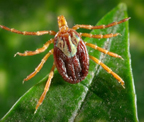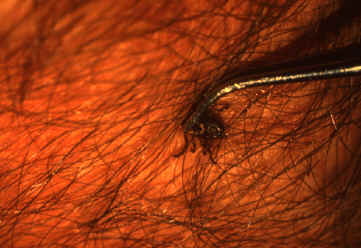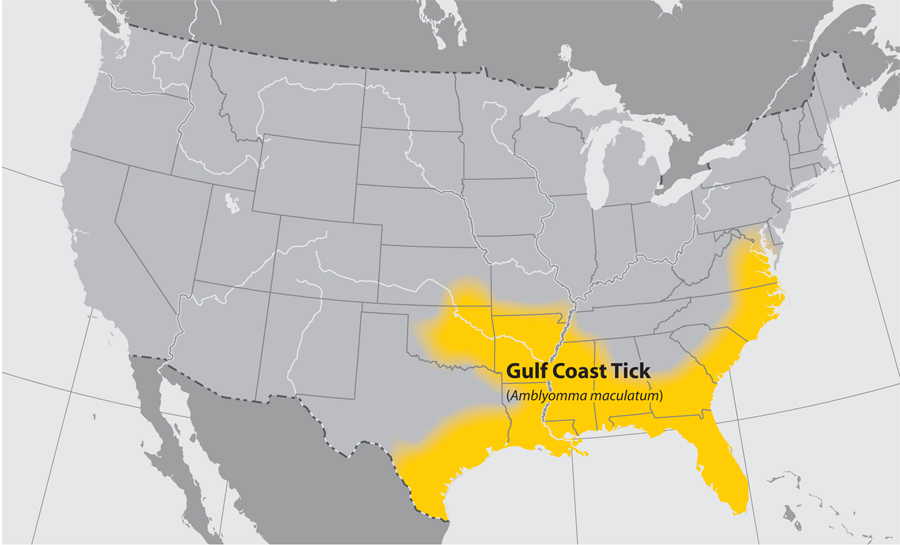Amblyomma maculatum
| style="background:#Template:Taxobox colour;"|Template:Taxobox name | ||||||||||||||
|---|---|---|---|---|---|---|---|---|---|---|---|---|---|---|
 | ||||||||||||||
| style="background:#Template:Taxobox colour;" | Scientific classification | ||||||||||||||
| ||||||||||||||
| Binomial name | ||||||||||||||
| Amblyomma maculatum Koch, 1844 |
Editor-In-Chief: C. Michael Gibson, M.S., M.D. [1] Associate Editor(s)-in-Chief: Ilan Dock, B.S.
Overview
Amblyomma maculatum, also known as the Gulf Coast tick, is commonly associated with the transmission of Rickettsia spotted fevers.
General Tick Life Cycle

- A tick's life cycle is composed of four stages: hatching (egg), nymph (six legged), nymph (eight legged), and an adult.
- Ticks require blood meal to survive through their life cycle.
- Hosts for tick blood meals include mammals, birds, reptiles, and amphibians. Ticks will most likely transfer between different hosts during the different stages of their life cycle.
- Humans are most often targeted during the nymph and adult stages of the life cycle.
- Life cycle is also dependent on seasonal variation.
- Ticks will go from eggs to larva during the summer months, infecting bird or rodent host during the larval stage.
- Larva will infect the host from the summer until the following spring, at which point they will progress into the nymph stage.
- During the nymph stage, a tick will most likely seek a mammal host (including humans).
- A nymph will remain with the selected host until the following fall at which point it will progress into an adult.
- As an adult, a tick will feed on a mammalian host. However unlike previous stages, ticks will prefer larger mammals over rodents.
- The average tick life cycle requires three years for completion.
- Different species will undergo certain variations within their individual life cycles. [1]
Spread of Tick-borne Disease
- Ticks require blood meals in order to progress through their life cycles.
- The average tick requires 10 minutes to 2 hours when preparing a blood meal.
- Once feeding, releases anesthetic properties into its host, via its saliva.
- A feeding tube enters the host followed by an adhesive-like substance, attaching the tick to the host during the blood meal.
- A tick will feed for several days, feeding on the host blood and ingesting the host's pathogens.
- Once feeding is completed, the tick will seek a new host and transfer any pathogens during the next feeding process. [1]
Hosts
Amblyomma maculatum is a species of tick in the genus Amblyomma. Immatures usually infest small mammals and birds that dwell on the ground; cotton rats may be particularly favored hosts.[2] Some recorded hosts include:
- Geothlypis trichas[3]
- Cardinalis cardinalis[4]
- Passerina ciris[4]
- Sialia sialis[4]
- Thryothorus ludovicianus[4]
- Troglodytes aedon[4]
- Zonotrichia albicollis[4]
- Dog (Canis lupus familiaris)[4]
- Dama dama[5]
- Human (Homo sapiens)[3]
- Eastern woodrat (Neotoma floridana)[6]
- Odocoileus virginianus[5]
- Marsh rice rat (Oryzomys palustris)[7]
- Cotton mouse (Peromyscus gossypinus)[8]
- Hispid cotton rat (Sigmodon hispidus)[9]
- Pig (Sus scrofa)[10]
- Sylvilagus palustris[10]
In 2013, the infectious agent of American tick bite fever, Rickettsia parkeri was detected in a female A. maculatum collected at Bombay Hook National Wildlife Refuge, near Smyrna, Delaware, providing the first evidence of association of this pathogen of humans with this species of tick in the state.[11]
Geographic Distribution
- Coastal areas of the United States along the Atlantic coast
- Coastal areas Gulf of Mexico
Prevention
Limiting tick exposure

It is unreasonable to assume that a person can completely eliminate activities that may result in tick exposure. Therefore, prevention measures should emphasize personal protection when exposed to natural areas where ticks are present:
- Wear light-colored clothing which allows you to see ticks that are crawling on your clothing.
- Tuck your pants legs into your socks so that ticks cannot crawl up the inside of your pants legs.
- Apply repellents to discourage tick attachment. Repellents containing permethrin can be sprayed on boots and clothing, and will last for several days. Repellents containing DEET (n, n-diethyl-m-toluamide) can be applied to the skin, but will last only a few hours before reapplication is necessary. Use DEET with caution on children. Application of large amounts of DEET on children has been associated with adverse reactions.
- Conduct a body check upon return from potentially tick-infested areas by searching your entire body for ticks. Use a hand-held or full-length mirror to view all parts of your body. Remove any tick you find on your body.
- Parents should check their children for ticks, especially in the hair, when returning from potentially tick-infested areas.
- Ticks may also be carried into the household on clothing and pets and only attach later, so both should be examined carefully to exclude ticks.[12]
The best way to remove a tick
- Use fine-tipped tweezers or notched tick extractor, and protect your fingers with a tissue, paper towel, or latex gloves. Persons should avoid removing ticks with bare hands.
- Grasp the tick as close to the skin surface as possible and pull upward with steady, even pressure. Do not twist or jerk the tick; this may cause the mouth-parts to break off and remain in the skin. (If this happens, remove mouth-parts with tweezers. Consult your health care provider if illness occurs.)
- After removing the tick, thoroughly disinfect the bite site and wash your hands with soap and water.

- Do not squeeze, crush, or puncture the body of the tick because its fluids may contain infectious organisms. Skin accidentally exposed to tick fluids can be disinfected with iodine scrub, rubbing alcohol, or water containing detergents.

- Save the tick for identification in case you become ill. This may help your doctor to make an accurate diagnosis. Place the tick in a sealable plastic bag and put it in your freezer. Write the date of the bite on a piece of paper with a pencil and place it in the bag. [13]
References
- ↑ 1.0 1.1 Life Cycle of Ticks that Bite Humans (2015). http://www.cdc.gov/ticks/life_cycle_and_hosts.html Accessed on December 30, 2015
- ↑ Clark et al., 2001, pp. 1383–1384
- ↑ 3.0 3.1 Wilson and Durden, 2003, table 2
- ↑ 4.0 4.1 4.2 4.3 4.4 4.5 4.6 Wilson and Durden, 2003, table 1
- ↑ 5.0 5.1 Wilson and Durden, 2003, table 5
- ↑ Clark et al., 2001, table III
- ↑ Clark et al., 2001, p. 1381
- ↑ Clark et al., 2001, table II
- ↑ Clark et al., 2001, table IV
- ↑ 10.0 10.1 Wilson and Durden, 2003, table 4
- ↑ David A. Florin, Ju Jiang, Richard G. Robbins & Allen L. Richards. 2013. Infection of the Gulf Coast tick, Amblyomma maculatum (Acari: Ixodidae), with Rickettsia parkeri: first report from the State of Delaware. Systematic & Applied Acarology 18(1): 27–29; http://www.acarology.org/saas/saa/saa18/2013-18-027-029f.pdf.
- ↑ General Tick Disease Information. Centers for Disease Control and Prevention (2015). http://www.cdc.gov/ticks/symptoms.html Accessed on December 30, 2015
- ↑ Tick Removal. Centers for Disease Control and Prevention (2015). http://www.cdc.gov/ticks/removing_a_tick.html Accessed on December 30, 2015
Literature cited
- Clark, K.L., Oliver, J.H., Jr., Grego, J.M., James, A.M., Durden, L.A. and Banks, C.W. 2001. Host associations of ticks parasitizing rodents at Borrelia burgdorferi enzootic sites in South Carolina. Journal of Parasitology 87(6):1379–1386.
- Wilson, N. and Durden, L.A. 2003. Ectoparasites of terrestrial vertebrates inhabiting the Georgia Barrier Islands, USA: an inventory and preliminary biogeographical analysis (subscription required). Journal of Biogeography 30(8):1207–1220.
Gallery
- Common name: Gulf Coast tick
- Scientific name: Amblyomma maculatum
- Reservoir: birds and small rodents (larvae and nymphs); deer and other wildlife (adult ticks)
- Geographic distribution: coastal areas of the United States along the Atlantic coast and the Gulf of Mexico
- Disease transmitted: Rickettsia parkeri rickettsiosis
-
Gulf Coast tick (Amblyomma maculatum)
Adapted from CDC -
Approximate distribution of the Gulf Coast tick
Adapted from CDC
